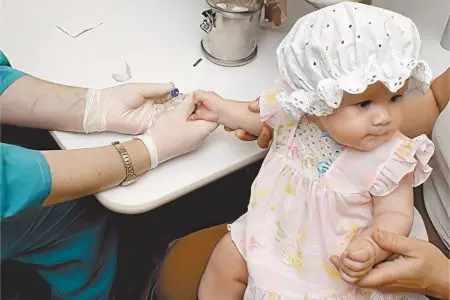Contents

Such a complex protein as hemoglobin, consisting of two components gemma and globin, is the basis of red blood cells. Its functional significance for the human body is great – after all, it is he who is involved in the transport of oxygen molecules from the lungs to the tissues, and also removes carbon dioxide and helps regulate the acid-base state (ACS).
In the blood, the protein is presented in two variations: as oxyhemoglobin (in combination with oxygen), and as reduced hemoglobin (giving oxygen molecules to tissues). If the former is found mainly in the arterial blood, giving it a bright scarlet color, then the reduced protein is present in the venous blood, which makes its color darker.
Naturally, hemoglobin plays a huge role in the life of the body and is an important indicator of its normal functioning. That is why, starting from birth, a blood test is taken from a person, where such an indicator as the quantitative determination of this protein is mandatory. Pediatricians around the world rightly pay great attention to ensuring that the hemoglobin in the child’s blood remains normal, since its decrease is fraught with unpleasant consequences.
Causes of low hemoglobin in a child
Depending on the age of the child, the reasons for the decrease in the vital protein may be different.
As for newborn babies, due to blood loss, increased destruction, or a general violation of the production of red blood cells, anemia may occur in a child:
The baby can lose a significant amount of blood during childbirth, this happens when premature placental abruption or rupture of the umbilical cord begins.
A low level of hemoglobin can also be in the case of increased breakdown of red blood cells, while the bone marrow cannot cope with the production of new proteins, due to its underdevelopment. Similar phenomena are often observed in premature babies aged 1-2 months.
Some diseases can also lead to increased breakdown of hemoglobin, such as hemolytic disease of the newborn. At the same time, antibodies that he received from his mother act in the body of the child. It is they who destroy the erythrocytes of the fetus.
Such a hereditary disease as spherocytosis is the cause of anemia in infants. Hemoglobin quickly breaks down due to the irregular, spherical shape of red blood cells.
The reason for the rapid destruction of red blood cells can also be an intrauterine infection received by a child, for example, rubella, herpes simplex or syphilis.
Even with initially normal hemoglobin levels, if there is insufficient dietary iron intake, hemoglobin levels may decline as early as 6 months of age, as the reserves received from the mother by this time are depleted.
As for children of preschool and school age, they have other reasons for reducing the level of hemoglobin in the blood:

Most often at an older age, the main reason is the child’s malnutrition. But it is worth understanding that it is not enough just to feed your child with foods rich in iron content. It will be absorbed only if certain vitamins and minerals (copper and manganese) are present in the body. As studies conducted by WHO have shown, this process is greatly facilitated by ascorbic acid. If it is present in the body, the assimilation of both organic (contained in products) iron and in the form of drugs occurs very quickly and almost in full.
If a child has a deficiency of folic acid and vitamin B12, the production of red blood cells is disrupted, and as a result, anemia will not take long. Often this is due to the fact that the baby receives few vegetables during the period of active growth, or they are cooked for too long.
The reason for the decrease in the level of hemoglobin, which is so necessary for the body, can also be various bleeding, both obvious and passing in a latent form. As for the former, for girls who are in the puberty phase, these are most often the onset of menstruation. If the discharge is abundant, then in most cases the hemoglobin level decreases. But with the right approach to nutrition, no additional funds are required. Also, with errors in the menu, hemorrhoids can develop, due to even small but regular blood losses, the treasured protein becomes less, and doctors can diagnose anemia. Naturally, due to various kinds of injuries and injuries, bleeding can occur, which will inevitably lower the level of hemoglobin. As for hidden bleeding, in children they can be observed with gastrointestinal disease.
Another reason leading to the problem described above can be a wrong lifestyle, namely: if a child spends little time on the street, does not move, does not play sports, then it is natural that his metabolism is disturbed. This will inevitably lead to the fact that the level of iron in the blood will be low. But it is worth considering that, on the contrary, increased physical activity can also lead to such a reaction of the body, when the child is engaged in excessive physical labor or a too hard sport.
Taking certain medicines in childhood, especially without medical supervision, can lead to anemia.
Hemoglobin in children up to a year

Most often, those children suffer from anemia, whose mothers during pregnancy did not take care to cure their iron deficiency anemia. Naturally, this is also transmitted to the baby, since its already small reserves are quickly depleted. The cause of early anemia, in addition to the above, can also be frequent colds of the mother during childbearing, or if the pregnancy is multiple. At the same time, at birth, all indicators of the crumbs are most often normal, but by the 3rd month, a blood test will reveal a low level of hemoglobin.
Surprisingly, the myths about artificial feeding and, as a result, the development of anemia are really myths. If a child receives a full-fledged adapted milk formula in the proportions necessary for his age and weight, as well as a well-introduced first complementary food, then he will not face iron deficiency. But there are exceptions here, it is not too early to transfer to a mixture, since a very young organism is sometimes not able to break down cow protein, on the basis of which mixtures are made.
As for some symptoms, children under one year old may show the following symptoms:
The skin becomes dry, even small cracks may appear, especially noticeable in the corners of the mouth. Hair and nails grow poorly, fall out and break.
The baby is lethargic, gets tired quickly, lags behind in development, due to changes in the muscles, does not begin to raise his head in time, roll over to one side and crawl.
The mucous membrane of the mouth dries up, stomatitis and thrush may appear, appetite is often reduced, the stool is disturbed. Moreover, both diarrhea and constipation can be observed.
Mental retardation is also observed, especially if anemia remains undetected. This is due to the fact that oxygen is not “supplied” to the brain in the proper level, it experiences corresponding starvation and cannot fully function.
The immunity of a baby up to six months of age depends on the antibodies received from the mother. Naturally, it will be reduced in those children whose hemoglobin is not at the proper level. Such babies from an early age are prone to frequent diseases of the upper respiratory tract, suffer from sinusitis and tonsillitis.
The rate of hemoglobin per year
The limits of the norm of an important protein for life can vary depending on the age of the child. The indicator that is adequate for a newborn baby will be overestimated for a one-year-old baby. That is why parents should be guided by the numbers indicating the normal values of the child’s hemoglobin.
Knowing these numbers and donating blood regularly, as prescribed by a doctor, you can monitor the normal level of hemoglobin and prevent the development of a disease such as iron deficiency anemia. This disease is very insidious and may not give itself away, while weakening the defenses of the baby’s body. Experts note that anemia is a fairly common disease that many children face. However, do not despair, because with timely diagnosis and adequate treatment, it disappears without a trace.
How to increase hemoglobin in infants?
Ways to increase hemoglobin in infants will directly depend on the cause that caused this condition.
If protein deficiency occurs due to blood loss during childbirth, then an immediate transfusion is required. With excessive destruction of red blood cells, an exchange transfusion is required. The child’s own blood is gradually and slowly replaced with a donor’s. Thanks to a similar procedure, damaged bilirubin and red blood cells, as well as maternal antibodies, are removed from the baby’s body. When direct treatment of anemia is required, appropriate iron preparations are prescribed, with the development of serious symptoms of the disease, a blood transfusion is performed.
Nursing mothers need to adjust their diet to include those foods that are rich in iron. After all, in infancy, children mainly eat only mother’s milk. With the introduction of complementary foods, it will be easier to raise the level of hemoglobin, since the child will be able to directly receive iron from food without “sharing” with the mother.
As for preventive measures, they begin at the stage when the child is in the womb. A pregnant woman should be registered in a timely manner, donate blood and treat anemia, if any. Infants, on the other hand, are shown adequate feeding, prevention of rickets and dystrophy. Measures should be taken in time to treat possible intestinal and infectious diseases, and, of course, do not forget about regular blood tests. This is especially true for children at risk.
How to raise hemoglobin in a child

Depending on the severity of anemia, you can raise the child’s hemoglobin in the following ways:
If the indicators fell below 110 g / l, but did not go beyond 100, then the baby’s nutrition should be adjusted and thus try to increase the hemoglobin level. For this, it is very important to eat not just meat products, but in combination with vegetables. So the percentage of iron absorbed in the intestine increases significantly. But about such drinks as milk, tea and coffee should be forgotten. Often pediatricians prescribe ascorbic acid. A dentist should be consulted to rule out gingivitis, as a child may lose blood when brushing their teeth. After adjusting the nutrition, a second blood test is performed, and if no improvement is observed, then appropriate drugs are prescribed.
If the indicators have reached the limit of 100 g / l, but not lower than 90, then preparations containing iron should be taken. Their choice should be taken very carefully, so in order to avoid many complications and improve absorption, preference should be given to the 3-valent iron contained in the tablets. Most often, the duration of the course is a month, after which a control blood sample is taken, if an increase in hemoglobin is observed, then the drugs are taken for another 60 days. All treatment must be carried out under the supervision of a physician.
If the level indicators have reached the level of 60 – 90 g / l, then one should proceed from the general condition of the child. Depending on it, either iron solutions are taken by mouth or intramuscular injections are prescribed. Blood counts are monitored every 10 days, self-medication is unacceptable.
When hemoglobin falls below the mark of 60 g / l, an emergency transfusion of erythrocyte mass is prescribed, since such conditions are a direct threat to life, first of all, the brain suffers.
It should be remembered that all treatment is carried out under the supervision of a doctor, hospitalization is required only in the last case, with severe anemia. At the same time, it is important for parents to remember that a balanced diet, combined with regular examinations, is the best prevention of iron deficiency anemia.
Author of the article: Sokolova Praskovya Fedorovna, pediatrician









